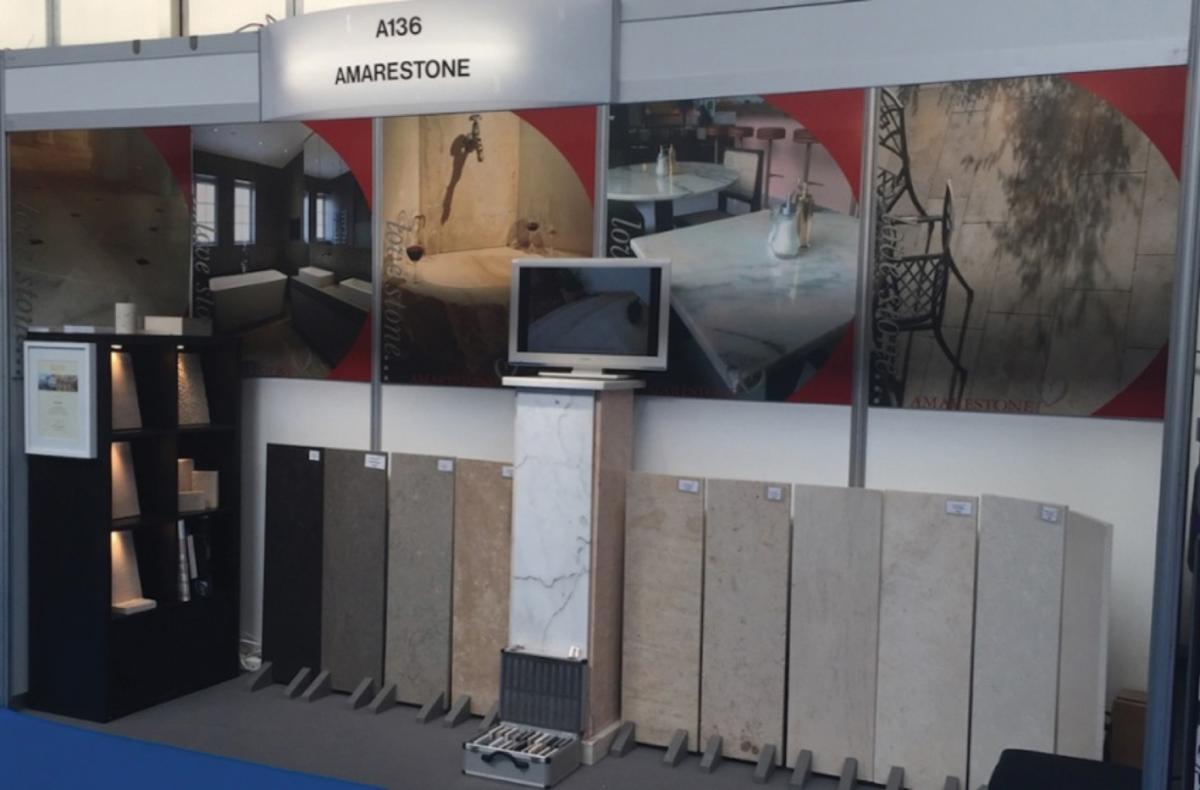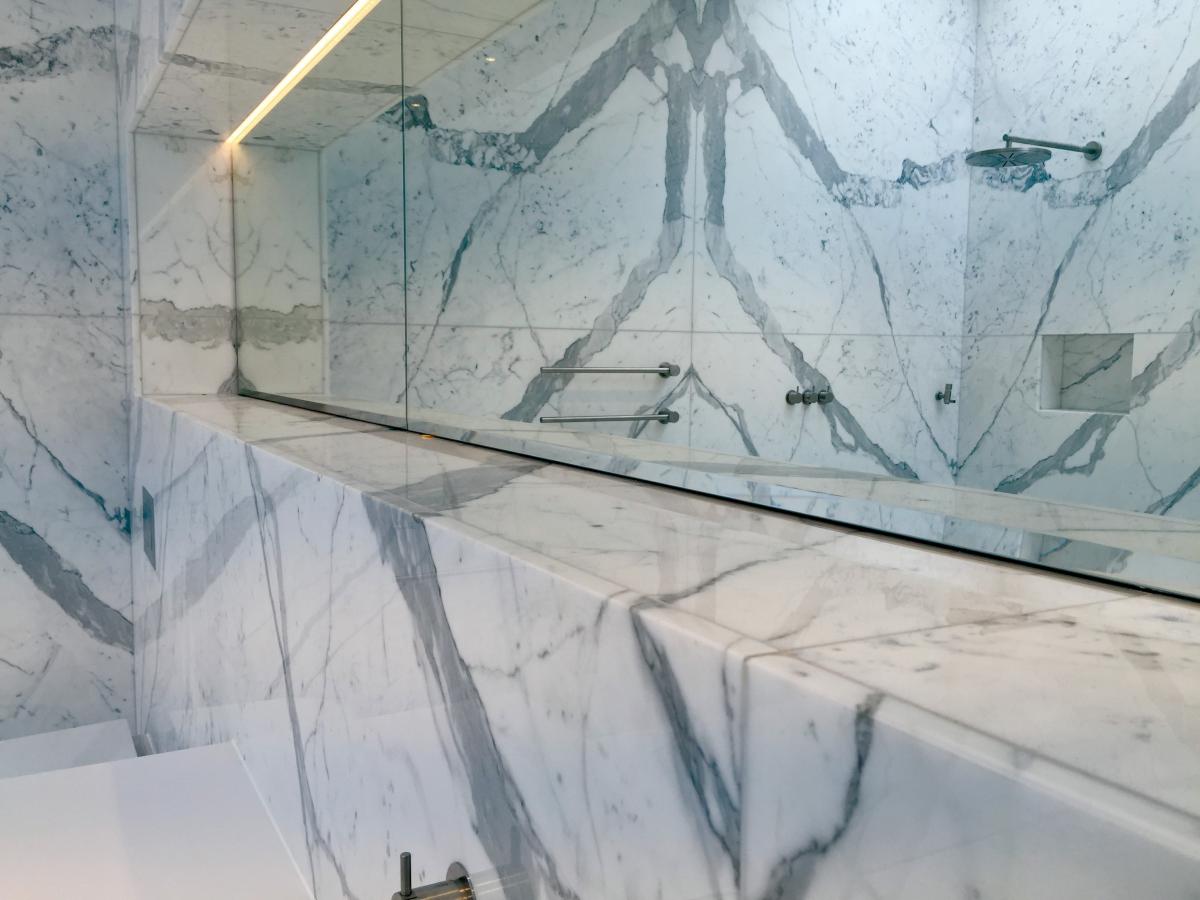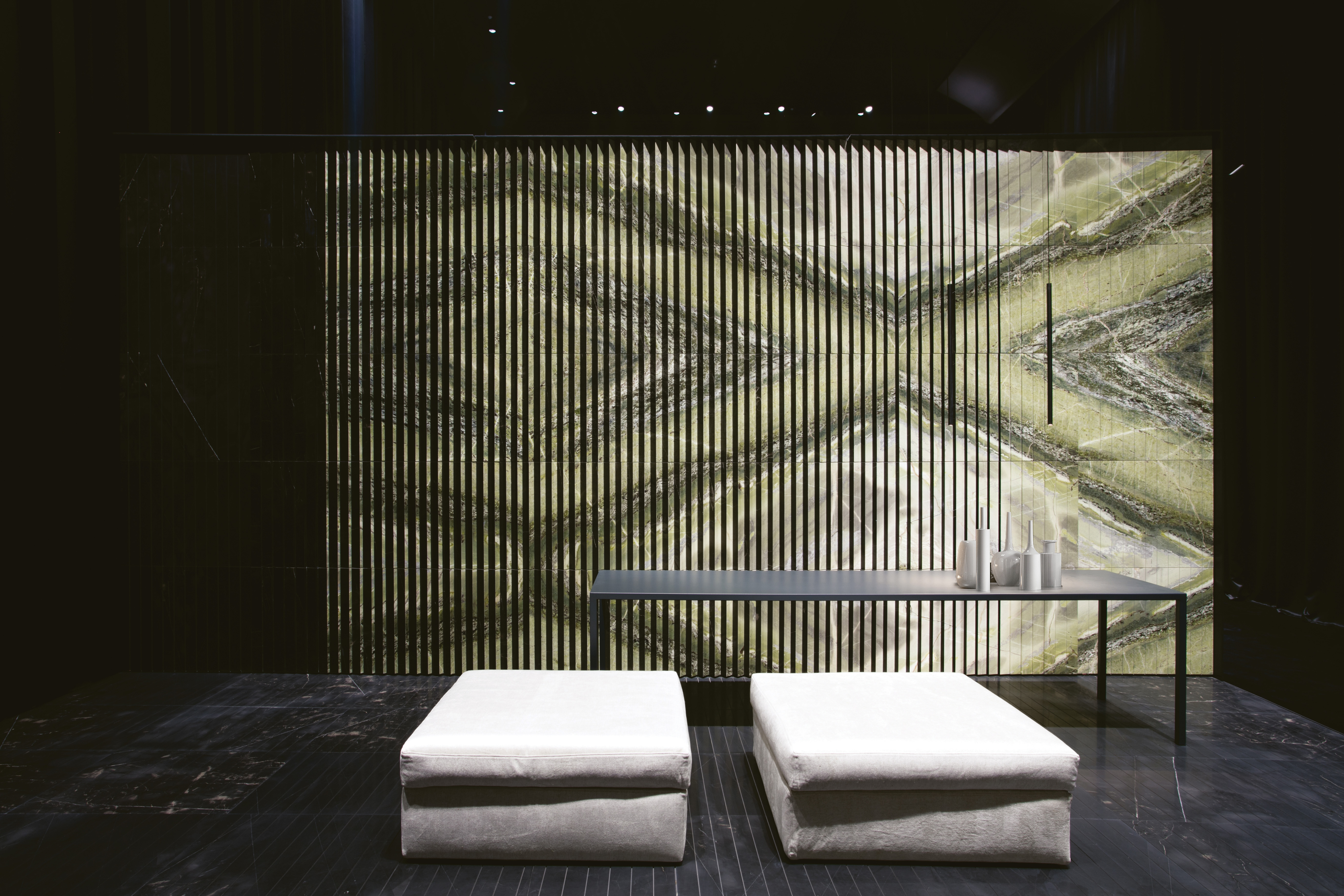Report : Stone in interiors
Nature has all the advantages – millions of years at its disposal, the pressure and heat provided by a planet, practically unlimited energy. Throw in the evolution of the human brain over the past 200,000 years or so and hey presto…
Nature works outside human timescales to create exquisite colours, patterns and textures that Man struggles to reproduce. But Man continues with the struggle… and he’s getting better at it all the time.
Just how much better is demonstrated at this year’s TTA Tile Awards, presented in London on 19 May.
Natural stone tiles have played a significant role in the Tile Awards over the years as designers and home owners have sought larger formats and the natural patterns that stone offers for their interiors.
The blurring of boundaries between interiors and exteriors has also given stone an advantage. But the makers of manufactured products have sought to reproduce every advantage stone has and entries in this year’s Tile Awards include as much as ever that looks like stone but less than usual that actually is.
The shift away from dark granite for work surfaces to lighter colours has undoubtedly benefitted the man-made products, especially since they started to include veining reminiscent of marble.
Marble is not favoured for worksurfaces because it stains, etches with acids and scratches relatively easily. The antique look is considered attractive by some but is not currently in vogue. Even people who want a honed, brushed, leather, dune or other textured finish want it to remain looking pristine. Man made products can look like marble but be more durable, which the makers of the latest quartz, sintered and porcelain products have emphasised with some enthusiasm.
According to paint company Dulux, this year’s must-have colour is Denim Drift with a supporting colour palette ranging from the lightest to the darkest blue. Dulux says the palette is “simple to understand and yet so new, sophisticated and versatile”.
Heleen van Gent, Creative Director at the Dulux Global Aesthetics Center, says: “Our review of international architecture, fashion and design trends revealed that blue is the colour of the moment. To make it relevant for your home, the team chose a blue that works as well in a kitchen as it does in a bedroom. Denim Drift is the must-have colour for 2017. It will look great on your wall! ”
There are undoubtedly trends in looks. The white marbled look is currently very much on trend for both horizontal and vertical surfaces in interiors, perhaps even more so in commercial premises than domestic. A feature wall in book-matched or quarter-matched marble undoubtedly makes a statement.
But whatever is trending, there are always people who buck that trend or have already moved on to what they believe will be the next trend. Steve Turner of Amarestone in Reading, Berkshire, has lately been using stands at exhibitions to try to discern what visitors to the exhibitions really do like. He has written about it on his blog (info.amarestone.com/blog).
 He recognises that blue and grey limestones are very much on trend but wonders if people really like them more than the traditional beige and light-coloured limestones, which he sells more of. So at the Homebuilding & Renovating Show at Birmingham’s NEC, he decided to put it to the test and show a range of colours from some of well over 100 stones from Europe’s quarries that Amarestone supplies.
He recognises that blue and grey limestones are very much on trend but wonders if people really like them more than the traditional beige and light-coloured limestones, which he sells more of. So at the Homebuilding & Renovating Show at Birmingham’s NEC, he decided to put it to the test and show a range of colours from some of well over 100 stones from Europe’s quarries that Amarestone supplies.
He arranged samples of a small selection of limestones on the company’s stand in order of dark to light with a column of Rosa Aurora in the middle. Then he kept track of which side of the display attracted most attention.
Which was it?
“Well, both ends, actually,” says Steve. “There was a fairly even split between the two and a good number who went straight to the middle of the display for a closer look at the column of Portuguese marble.
“The grey/blue range appealed to the visitors who were looking for contemporary flooring to use internally and externally to create the seamless inside-outside look.
“The limestones that particularly grabbed people’s attention were the two Spanish limestones Cenia Grey and the Grey Venezia (also known as Siera Elvira). As we explained to the visitors, any stone that is going to be used outside must have good frost resistance. This can be demonstrated in the test results that are given in the CE Certificate. Our Buxy Bleu French limestone is another great example of a blue/grey stone that is very tough, making it suitable for high traffic areas.
“The lighter grey limestone, Ataija Azul, [third from the left in the picture of the Amarestone stand below] is a hard Portuguese limestone that works beautifully as internal flooring, particularly in the brushed finish.
“The rest of our display was made up of French limestone from quarries in Burgundy and South West France.
“The Chamesson Coquillé, with its bold fossils, was the one that most people came forward to touch and feel.” Chamesson has an excellent pedigree and can be seen in many prestigious locations around the world, including London’s Canary Wharf.
“Overall, based on our experience at this show, it appears that grey/blue stone is just as popular as the beige/white stone but I did note that the people who looked at the grey end didn’t generally cross over to the lighter end, nor vice versa.”
Given the result of Steve’s experiment and predictions of blues being the next interiors trend, Steve wonders if Amarestone’s blue/grey stone sales are about to catch up with sales of the lighter stones. But he wonders: “Do people feel bold when they are looking at samples but then play safe when they make the decision to buy? It seems that way at the moment.”
If anyone is looking for advice on which stone to select for a project, Steve would be happy to get involved. You can email him on advice@amarestone.com.
Another company happy to help is Granite, Marble & Limestone (GML), with premises in Lancashire and Newbury Street, London. The company was one of just two honoured in the Interiors category of Stone Federation Great Britain’s Natural Stone Awards presented by Michael Portillo in London in December.
 Its entry was a fully panelled, book-matched Statuario marble master bathroom to a large new development in Surrey (pictured above). It leaves no doubt about why the white marble look is so popular.
Its entry was a fully panelled, book-matched Statuario marble master bathroom to a large new development in Surrey (pictured above). It leaves no doubt about why the white marble look is so popular.
The slabs for the project were approved by the client on a trip to Italy with GML. Each slab was book matched and polished at the factory. They were photographed and the photographs used by the drawing department to produce exact setting out renders and adjusted to suit the architect.
Site access and location meant that installation was akin to a military operation, with specialist plant and lifting gear. Even so, one of the key wall panels had a small flaw and shattered during the final stages – just one of the unpredictable issues that can arise when working with natural materials.
GML had made provision for such an eventuality by procuring two extra scants and because of the consistency of the block the book-match was maintained and the overall design did not suffer as a result.
While this demonstrates how important a role a skilled stone company plays in such a project, GML Managing Director Paul James Pratt says it also highlights the perceived disadvantages of natural stone – those pesky Italian mountains just don’t make a stone that is infallible!
Natural flaws and the sheer size of the stone elements meant the architect had to trust the contractor to manage all the practicalities. As Paul says, it takes great expertise and knowledge to manage natural stones, both at source and throughout any project.
Another project GML was asked to fabricate and install was a kitchen in Arabescato Orobico marble from Italy.
The architect needed the stone to wrap around the sides and top of a trapezoidal frame, giving an angular appearance but retaining the key veining right round the piece at the same distance. Paul says it was more like a sculpture than a kitchen, with the designer again relying heavily on GML’s competence, organisational skills and sheer artistic flair.
The designer is also taking a risk and has to have the imagination to rework ideas based on the actual stone being used. For a single vein to match from one plane to another involves discarding a considerable amount of stone, wastage often not considered by clients’ quantity surveyors or design teams.
By contrast, composite quartz is produced in standard sizes. It is straightforward to specify and predictable in use. “The romance of natural tonal variation and veining is not present, but there is as much opportunity to use form and colour to create drama,” says Paul. “Costing is also straightforward and the design team can be aware of the slab sizes and likely wastage from the project's inception.”
There is more from Paul James Pratt about natural stone compared with quartz composites on this website – bit.ly/GMLltd.
While a lot of imported stone is chosen for interiors for aesthetic reasons, British stones have their place and one of the most spectacular examples lately has been the use of Albion Stone’s Jordans Basebed Portland limestone for the internal wall linings of a £260million rebuild at 1&2 New Ludgate, which won the City of London Building of the Year Award last year.
The canvas of stone in a contemporary, bold, geometric pattern emphasises the vast amount of space that travels through New Ludgate’s large glazed double-height entrance into the street beyond. The process involved Putney & Wood’s in-house designers using CAD to detail every stone before creating a visual representation of each elevation. Shaping of the stone for the wall was split between CNC machinery of 3D Pierre, stoneCIRCLE and Albion Stone.
***************************************
The Domestic Kitchen and Bathroom Worktops Market Report - UK 2016-2020 Analysis is now in its 4th edition. Published by AMA Research May 2016. Pages: 69. Price £745. www.amaresearch.co.uk
The value of the overall kitchen and bathroom worktop market is estimated to have reached in excess of £200million in 2015, reflecting a recent recovery in the market after the difficult post-recession trading period, says AMA Research in its Domestic Kitchen and Bathroom Worktops Market Report.
In the bathroom worktop market, growth resumed in 2012. In 2015, the market saw growth of 8%, though from a low base, and in value terms regained the level seen in 2007 prior to the economic downturn. Bathroom worktops remain a small market in overall value terms. Builders and plumbers merchants are the major distributors for bathroom worktops with around 40% of the market, followed by DIY multiples and bathroom equipment specialists.
Major issues that are currently influencing this market include; rising levels of consumer confidence, which has increased the demand for design-led features in the bathroom; increase in the popularity of solid surfaces for worktops, partly because they can be worked into any shape and can be used to create an integrated basin, worktop and splashback; and a growth in the number of second bathrooms in the new housing market. However, the relatively high proportion of flats and apartments in the new housing sector and the generally small size of bathrooms in the UK have tended to limit growth in the worktops sector. Although the demand for bathroom furniture and worktops is likely to show only modest growth until 2020, in the medium to long term the projected increases in the level of housebuilding volumes may lead to increased requirements for bathroom equipment, including bathroom furniture and worktops.
The value of the total kitchen worktop market is estimated by AMA Research to have increased by around 5% in 2015, following a number of years with relatively good growth of 4-5% per annum. The structure of the worktops market is highly fragmented, with raw material suppliers, importers, manufacturers, fabricators and distributors all being involved. The distribution channel structure has experienced some changes in recent years, with growth in the builders merchants sector, while the DIY multiples sector has lost market share recently. Key issues that have influenced the market in recent years include an emphasis on aesthetics and stylish designs; the blurring of distinction between the kitchen and dining room, with less formality in the home and a move towards open plan living; a growing interest in cooking as a hobby and the demand for professional style kitchens and appliances with a trading up to higher value materials and products.
Growth in the market for kitchen worktops has been steady in recent years, as wider economic and market conditions have improved and steady growth is forecast until 2020. As the kitchen market continues to grow, both natural stone and composite materials are forecast to gain market share.

